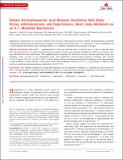Files in this item
Dietary docosahexaenoic acid reduces oscillatory wall shear stress, atherosclerosis and hypertension, most likely mediated via an IL-1-mediated mechanism
Item metadata
| dc.contributor.author | Alfaida, Mabruka | |
| dc.contributor.author | Chamberlain, Janet | |
| dc.contributor.author | Rothman, Alexander | |
| dc.contributor.author | Crossman, David Christopher | |
| dc.contributor.author | Villa-Uriol, Maria-Cruz | |
| dc.contributor.author | Hadoke, Partick | |
| dc.contributor.author | Wu, Junxi | |
| dc.contributor.author | Schenkel, Torsten | |
| dc.contributor.author | Evans, Paul | |
| dc.contributor.author | Francis, Sheila | |
| dc.date.accessioned | 2018-07-05T13:30:05Z | |
| dc.date.available | 2018-07-05T13:30:05Z | |
| dc.date.issued | 2018-07-03 | |
| dc.identifier | 253247795 | |
| dc.identifier | 97cf29c6-1c3a-4a0c-a208-da8915ecc548 | |
| dc.identifier | 85049679169 | |
| dc.identifier | 000452700100023 | |
| dc.identifier.citation | Alfaida , M , Chamberlain , J , Rothman , A , Crossman , D C , Villa-Uriol , M-C , Hadoke , P , Wu , J , Schenkel , T , Evans , P & Francis , S 2018 , ' Dietary docosahexaenoic acid reduces oscillatory wall shear stress, atherosclerosis and hypertension, most likely mediated via an IL-1-mediated mechanism ' , Journal of the American Heart Association , vol. 7 , no. 13 , e008757 . https://doi.org/10.1161/JAHA.118.008757 | en |
| dc.identifier.issn | 2047-9980 | |
| dc.identifier.other | ORCID: /0000-0003-4762-8623/work/60196620 | |
| dc.identifier.uri | https://hdl.handle.net/10023/14997 | |
| dc.description.abstract | Background Hypertension is a complex condition and a common cardiovascular risk factor. Dietary docosahexaenoic acid (DHA) modulates atherosclerosis and hypertension, possibly via an inflammatory mechanism. IL‐1 (interleukin 1) has an established role in atherosclerosis and inflammation, although whether IL‐1 inhibition modulates blood pressure is unclear. Methods and Results Male apoE−/− (apolipoprotein E–null) mice were fed either a high fat diet or a high fat diet plus DHA (300 mg/kg per day) for 12 weeks. Blood pressure and cardiac function were assessed, and effects of DHA on wall shear stress and atherosclerosis were determined. DHA supplementation improved left ventricular function, reduced wall shear stress and oscillatory shear at ostia in the descending aorta, and significantly lowered blood pressure compared with controls (119.5±7 versus 159.7±3 mm Hg, P<0.001, n=4 per group). Analysis of atheroma following DHA feeding in mice demonstrated a 4‐fold reduction in lesion burden in distal aortas and in brachiocephalic arteries (P<0.001, n=12 per group). In addition, DHA treatment selectively decreased plaque endothelial IL‐1β (P<0.01). Conclusions Our findings revealed that raised blood pressure can be reduced by inhibiting IL‐1 indirectly by administration of DHA in the diet through a mechanism that involves a reduction in wall shear stress and local expression of the proinflammatory cytokine IL‐1β. | |
| dc.format.extent | 19 | |
| dc.format.extent | 2516485 | |
| dc.language.iso | eng | |
| dc.relation.ispartof | Journal of the American Heart Association | en |
| dc.subject | Docosahexaenoic acid | en |
| dc.subject | Endothelium | en |
| dc.subject | Hypertension | en |
| dc.subject | Inflammation | en |
| dc.subject | Interleukin 1 | en |
| dc.subject | Wall shear stress | en |
| dc.subject | RB Pathology | en |
| dc.subject | NDAS | en |
| dc.subject.lcc | RB | en |
| dc.title | Dietary docosahexaenoic acid reduces oscillatory wall shear stress, atherosclerosis and hypertension, most likely mediated via an IL-1-mediated mechanism | en |
| dc.type | Journal article | en |
| dc.contributor.institution | University of St Andrews. School of Medicine | en |
| dc.contributor.institution | University of St Andrews. Office of the Principal | en |
| dc.identifier.doi | 10.1161/JAHA.118.008757 | |
| dc.description.status | Peer reviewed | en |
This item appears in the following Collection(s)
Items in the St Andrews Research Repository are protected by copyright, with all rights reserved, unless otherwise indicated.

